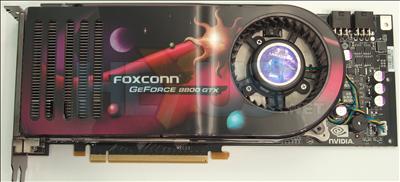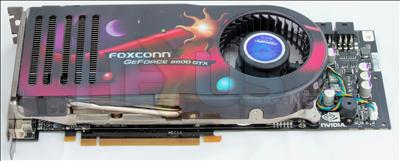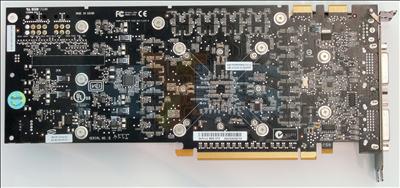Card appearance and thoughts
There's little need to repeat ourselves ad nauseum and roll out the reasons why we believe the GeForce 8800 GTX GPU is fundamentally better than anything else currently available. Head on over to our technical take should you need a refresher on what makes G80 abundantly special in our eyes. The premise of this review is to focus on the Foxconn package and compare it with its immediate competition from another NVIDIA AIB, and to look at performance against other high-end cards from NVIDIA and ATI.Foxconn loves to leave your memory etched with memorable card names. This one's the Foxconn GeForce 8800 GTX FV-N88XMAD2-OD. Should be easy enough to remember, right? The codes are actually very sensible and offer pertinent information when deciphered, but this end of the market is usually graced by nomenclature along the lines of 'Super Rockin' Remortgage Required Wonderfun Edition XXX Rev 5.21'
Attempted and failed hilarity aside, the Foxconn model can only be visually distinguished from a bunch of other GeForce 8800 GTXs by the artwork on the cooler. That makes it real big, measuring in at 267mm x 98.5mm. Its size caused no installation problems on a couple of high-end Intel i975X and nForce 680i SLI motherboards and it's shorter than the gargantuan first-issue GeForce 7950 GX2.
GeForce 8800 GTX, as you might expect, is also somewhat porky, weighing in at 740g or so. Most of that weight is attributed to the huge heatsink that's required to dissipate up to 200W of heat, which, as a guide, is more peak wattage put out than well-designed low-to-midrange PCs. To NVIDIA and by extension Foxconn's credit, the cooler is extremely quiet in 2D and barely heard when the GPU is going full bore.
A side-on shot highlights the heatpipe nature of the cooling and the concurrent cooling of the memory chips. GeForce 8800 GTXs are equipped with a 768MiB framebuffer that's composed of 1800MHz-rated GDDR3 memory connected to the GPU via a 384-bit pathway. That's around 86.4GB/s of juicy bandwidth; the highest of any current card, unsurprisingly.
We'd love to show you the kitsch blue LEDs Foxconn has added to its card for the ultimate bling factor. Our sample didn't feature them, however Foxconn provided us with a picture of a GTS version equipped with said LEDs. Nice, eh?
All that GPU power is physically manifested with NVIDIA requiring the use of PSU-supplied power into 2 6-pin PEG connectors. Again, this is a first for consumer graphics cards and you'll need to invest in a high-quality PSU, if you haven't done so already, in ensuring adequate wattage is delivered to the card, which'll probably be housed in a high-quality, powerful system that's capable of pulling 400W+. Add in a second for SLI fun and you'd need to be looking at a handful of NVIDIA-approved 800W+ supplies.
A couple of HDCP-enabled DVI ports can each run esoteric resolutions of 2560x1600 and the card's power is such that a 4MP display is required to really stretch it. Pray that Santa brings you a couple of these cards and a 30in panel in his sleigh.
We've made no secret of liking NVIDIA's G80 cooler so we have no complaints with the dual-slot configuration. We'd be interested to hear from any company that can design an air-cooled, single-slot-taking heatsink for GeForce 8800 GTX. Right now, though, the motherboard slot adjacent to the primary x16's will be rendered useless.
Everything that applies to the reference card naturally applies to the Foxconn variant. It's clocked in at 575MHz core (1350MHz for the shaders) and 1800MHz memory, utilises a unified shading architecture (hardware), and is faster and has better image quality than another other class of GPU. Blatantly leaving out the issue of price, an AIB partner can do no wrong with G80; the technology is good enough to sell itself. Foxconn's just along for the ride.














